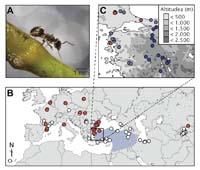Invasive ants help each other to occupy large surfaces

Invading ants create supercolonies to encompass large territorial areas in collaboration with other colonies. This has been demonstrated in international research by scientists from the Autonomous University of Barcelona and CREAF (Centre de Recerca Ecologica i Aplicacions Forestals).
Some species of ants occupy large territorial areas. To do this, in collaboration with other colonies, they create supercolonies and nesting nets with abundant queen. Non-invaders normally compete with other colonies, a strategy in which the key to being invaders or non-invaders is found. Two species of ants of the same origin were analyzed: the garden ant, Lasius neglectus, invasive; and the Turkish garden ant, Lasius turcicus, non-invasive. The results showed that the ability to invade comes from its origin. In Lascius turcius, researchers also discovered biological variables prone to invasion, but this capacity does not really manifest itself until ants are safe from their natural enemies.
According to scientists, the 12,500 known species of ants in the world can be a serious problem if no action is taken. They warn that the question can become global.





